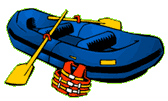WHITE-WATER RAFTING ACTIVITY CARD
Parts of the Body Worked

Upper & Lower Legs

Knees & Ankles

Arms

Back

Abs

Hips & Butt

White-water rafting is an exciting way to see the great outdoors while testing your strength and ability to think on your feet.
Gear Up
You’ll need a raft and paddles (usually 8 people per raft) to navigate the rapids, as well as a good life jacket and helmet. If you’re heading out into cooler temperatures, wear warm, waterproof clothing and wool socks—these will keep you warm and dry while splashing down the river. If it’s warm outside, nylon shorts, a bathing suit or swim trunks, a t-shirt, or a tank top are all good choices—just make sure to lather on that sunscreen to protect yourself from the sun. As for shoes, your best bet is to wear a pair with rubber soles or slip-on water shoes that you don’t mind getting wet—because even during a good run, you’re sure to get wet!
Some rafting trips can take a few hours (or even an entire day), so pack plenty of drinking water and food—just make sure to pack it up tight to keep the water out.
Play it Safe
Before jumping into that raft, it’s important to know how to swim. Even if you’re a strong swimmer, always wear a life jacket. It should fit snugly and have back and shoulder protection as well as floatation to help you swim safely in white water. Also, don’t forget to wear your helmet—it should be designed for water sports, fit properly and snugly on your head, and allow for water to drain from the helmet. It should also cover your ears, temples, and the back of your neck. Once you have the proper gear and are sure it’s all in working order, you’re ready to run the river.
It’s also really helpful if you’ve done a little exploring first. Make sure you know the river you are rafting on—check out the rating of the rapids and what the current is like. It’s best to a have a trained, experienced guide on your team and in your raft. The guide will know the best course and the safest passage. Don’t enter a rapid unless you’re sure you can run it safely or swim it without getting hurt. If you fall out of the raft, position your body so that you are on your back with your feet facing down river—try to keep your feet and legs up.
Usually a group of three boats is the minimum on a river—but only one boat should run the rapids at a time. Safe rafting is all about teamwork, so pick a captain to call out directions so everyone can work together.
Most importantly, be prepared! Get a first aid and survival kit, and include extra ropes, a raft repair kit, and extra life vests. Better safe than stranded!
How to Play
White-water rafting is definitely a team effort—that’s why understanding the basics of paddling are so important. If everyone in the raft gives it their all, it’s much easier to guide the raft down the river and through the rapids.
Once you’re in the raft, sit facing downriver with your back to the stern (back of the raft). Hold the paddle with your inside hand (the hand farthest away from the paddle) on top and your outside hand, knuckles facing out, gripping the paddle low on the stern. Lean forward from your hips, straighten your arms out in front of you, and keep your back straight. Straighten your wrists and put the paddle into the water—make sure the blade is completely under the surface of the water. Straighten your top arm while pulling back the paddle with your lower arm guiding the paddle. Reverse this motion to back paddle. If you want to turn the raft right, the right side of your rafting team needs to paddle backward while the left side paddles forward. The same goes for turning left except the members on the left side of the raft need to paddle backward and the right side forward. Rafting is all about communicating and working as a team!
Ology
Water is strange stuff—whether it’s in a glass, frozen like an ice cube, or boiling on the stove, it’s pretty much all the same, but when it starts to move, the physics of water becomes very complicated.
It’s easy to see how powerful Mother Nature is when you watch rapids in a fast-flowing river. Water pounds against rocks, sprays into the sky, and boils into white foam. Rapids look chaotic, but really are predictable. The volume of water, the steepness (or gradient) of the river, the width of the channel, and the obstacles in the water all have effects on the rapids. The river’s speed increases as more water flows through it—double the water means double the speed, so a mild rapid becomes a dangerous one during the rainy season. Rafters also must know the flow because water is heavy, and in rapids it exerts tremendous pressure on a raft.
Fun Facts
The Blue Nile River in Africa has rapids that are classified from 1-10, while American rivers are only classified up to a 6.
The Ocoee River in southeastern Tennessee is rated among the top white-water recreational rivers in the nation and was the site of the 1996 Olympics white-water competition.
Idaho has more stretches of white water than any other state in the Lower 48—about 3,250 miles!
Related Links
- Page last reviewed: September 14, 2017
- Page last updated: September 14, 2017
- Content source:



 ShareCompartir
ShareCompartir